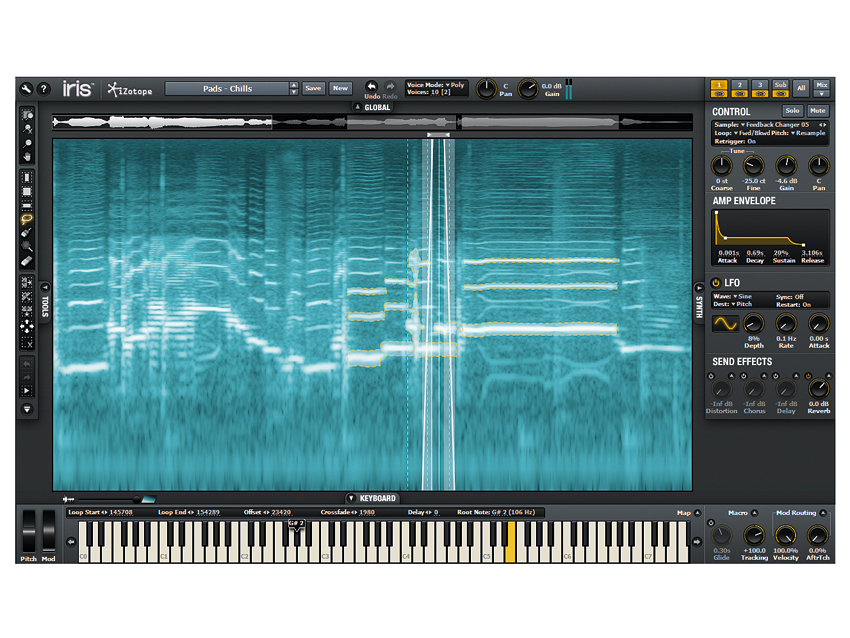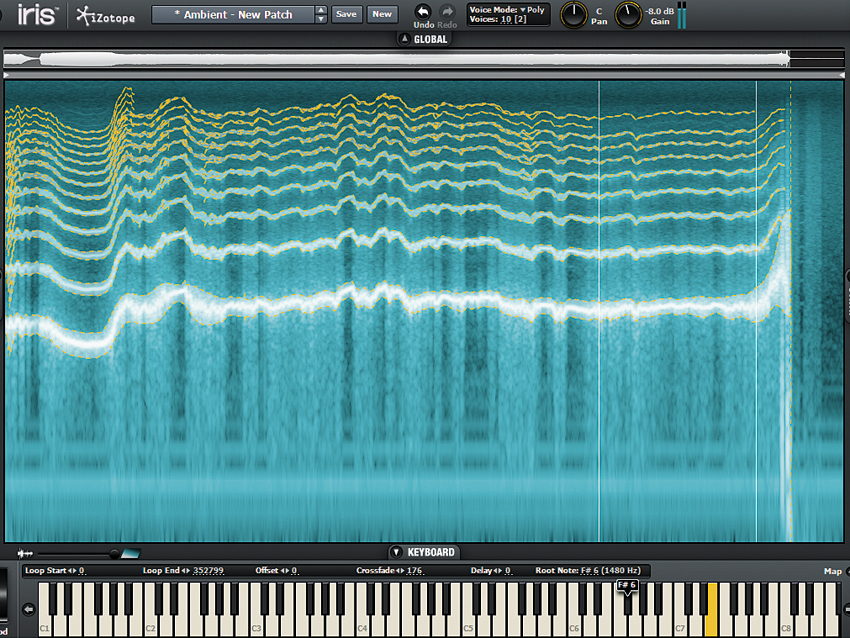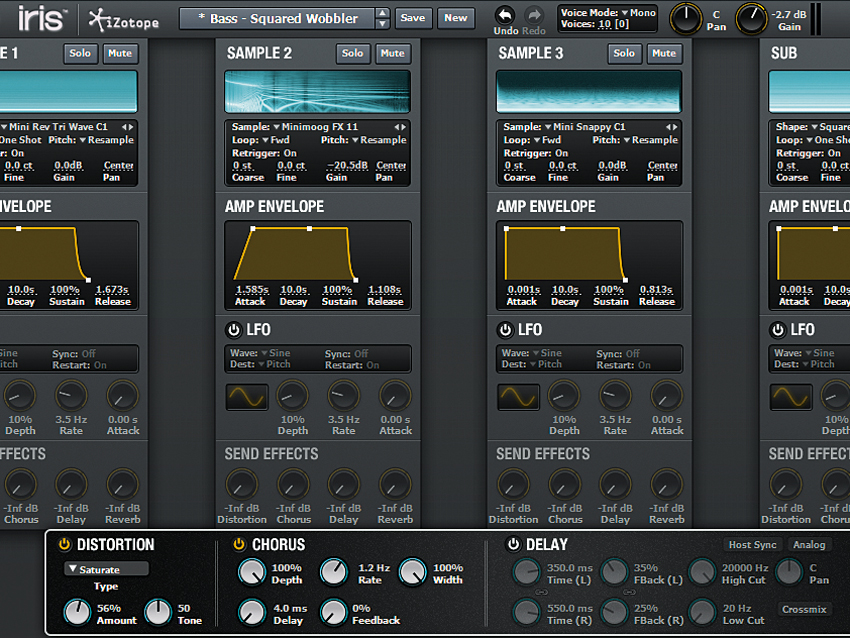MusicRadar Verdict
Iris makes spectral sound design easier and more fun than ever - put in the effort to master it and you'll reap the rewards.
Pros
- +
Can make any sound musical; visual spectrogram editing; maps pitch automatically; huge, high-quality library; MIDI Learn functionality.
Cons
- -
Best results require patience; selection tools lack some options.
MusicRadar's got your back

iZotope Iris

iZotope Iris

iZotope Iris
It seems that the spectral revolution is in full effect, and high-end developer iZotope is embracing it fully.
iZotope's spectrogram-based audio restoration suite, RX, brought us world-class audio manipulation - aimed primarily at restoration jobs, but a creative secret weapon for those in the know. The company's latest release, Iris, repurposes some of that spectral technology to make a virtual instrument (VST/VST3/AU/RTAS/standalone) that iZotope bills as a sampling resynthesiser.
"Iris is capable of pumping out an endless procession of strange and never-before-heard sounds."
So, what exactly is spectral technology all about? Well, in simple terms, a spectrogram maps out the spectral contents of a sound in three dimensions. The horizontal X axis represents time, just as with a normal waveform view, but the vertical Y axis represents frequency rather than amplitude.
This means that the top of the graph is where the treble resides, while the bass frequencies hang out at the bottom of the display. The third dimension (ie, equivalent of the Z axis), which represents amplitude, is indicated using brightness.
Draw something
Iris gets to work as soon as you drag in a sample, automatically detecting the pitch and mapping it across the keyboard. By default, it uses resampling to keyscale (playing the sample faster to go higher, and slower to go lower), but there's also the optional Radius RT.
This is a real-time version of iZotope's proprietary timestretching and pitchstretching algorithm, which preserves the sample length independent of the pitch.
Unlike a standard waveform-style audio editor, Iris's Spectral view is actually used for isolating the parts of the sound spectrum that you want to hear on playback. To do this, you're provided with an array of graphical editing tools.
You could be forgiven for thinking of it as a filter of sorts - and in a way it is - but this is nothing like the filters you might find in your analogue synth emulations. The spectral selections made here represent sharp and clinically 'masked out' portions of the sound that can be drawn to take pretty much any shape you like.
For example, throw in a bright synth pad sample and use the graphical tools to make multiple selections in a speckled, polka dot configuration to produce a twinkling, bird-like atmosphere. Alternatively, if you were to select the entire sample and then draw in a deselection pattern, all manner of phasing, swirling, evolving sounds would be heard on playback due to the 'holes' created in the frequency spectrum.
To give a few more usage examples, you could load a recording of wind blowing through trees and select a narrow band of frequencies to create a shimmering, flute-like patch. Or you might find yourself layering samples (see below) and selecting the characteristics you want to isolate from each (great for drum parts). There's also a lot of mileage to be had loading in random chunks of audio for processing into glitch-type effects.
The editing process is great fun to experiment and play around with, and the interface itself is extremely powerful. Most notably, the magic wand selection tool is capable of detecting harmonic content that's similar to the current selection, then finding and selecting related harmonic overtones with a second click.
Our one criticism in this area is that the non-freehand tools don't feel quite comprehensive enough. It would be good to be able to draw diagonally and even better to be able to soften the edges of selections; we'd love it if future updates included these features.
Layer cake
Iris enables the layering of up to four sounds per patch. The Mix window gives you control over these layers, including the application of amp envelopes, assignable LFOs and a selection of effects.
The first three layers are for your imported samples, while the fourth is the Sub, hosting a menu of 10 low-end‑boosting waveforms. You can still edit these using the spectral view, but the idea behind this particular layer is that it should be used to fatten up the overall patch with something solid that might not be inherently present in the samples you've imported.
Of course, you don't have to use this layer as a sub, and there's nothing to stop you starting a patch off here if you want to, although you should be aware that it can only load its preset waveforms.
The effects on offer include distortion, chorus, delay and reverb. They're all very high quality and can be used in either send or master (insert) mode.
The Mix window also gives you access to a global filter, which features its own envelope and offers a choice of ten different resonant types, which are modelled on a range of analogue filters. All of this makes Iris a sonic chameleon that can easily generate fat bass and melodic patches as well as its trademark quirky sounds.
Full spectrum
Iris is capable of pumping out an endless procession of strange and never-before-heard sounds, similar in quirkiness to other esoteric (re)synthesis methods, such as granular. However, you don't have to be a sound design genius to make the most of it straight out of the box - a diverse bank of over 500 well-organised and inspiring presets is included, drawing on a library of samples that weighs in at around 4GB.
As well as unusual soundscapes and ambiences, Iris is thoroughly capable of producing lush pads, glowing piano patches andother more 'conventional' sounds, with the unmatched ability to add intricate details that would be nigh-on impossible using traditional synthesis methods. It also excels as a general sampler, although using it as such would be to completely miss the point, of course.
Limitless possibilities
As you can probably appreciate, Iris is the sort of application that you really have to try yourself before you can grasp it fully. The interface is well-laid out and the built-in tour teaches you everything you need to know to get started.
If you've never even heard of spectral editing before, it might take some hours of trial and error in the spectrogram before you start to get consistent, predictable results, but take our word for it: the creative potential contained within this program is absolutely immense - potentially limitless, in fact.
Iris deserves to be a big hit with sound designers and hunters of new and unusual noises. If the idea of taking total control over every aspect of your samples, precisely extracting frequency-defined sections and then creating truly unique sounds out of them gets your imagination going, then this is a phenomenal studio tool that you absolutely have to try.
Computer Music magazine is the world’s best selling publication dedicated solely to making great music with your Mac or PC computer. Each issue it brings its lucky readers the best in cutting-edge tutorials, need-to-know, expert software reviews and even all the tools you actually need to make great music today, courtesy of our legendary CM Plugin Suite.
“Built from the same sacred stash of NOS silicon transistors and germanium diodes, giving it the soul – and snarl – of the original”: An octave-fuzz cult classic returns as Jam Pedals resurrects the Octaurus
What’s the buzz? Meet Yellowjacket, Cherry Audio's recreation of EDP’s trend-setting Wasp from 1978
“A fabulous trip through all eight songs by 24 wonderful artists and remixers... way beyond anything I could have hoped for”: Robert Smith announces new Cure remix album










